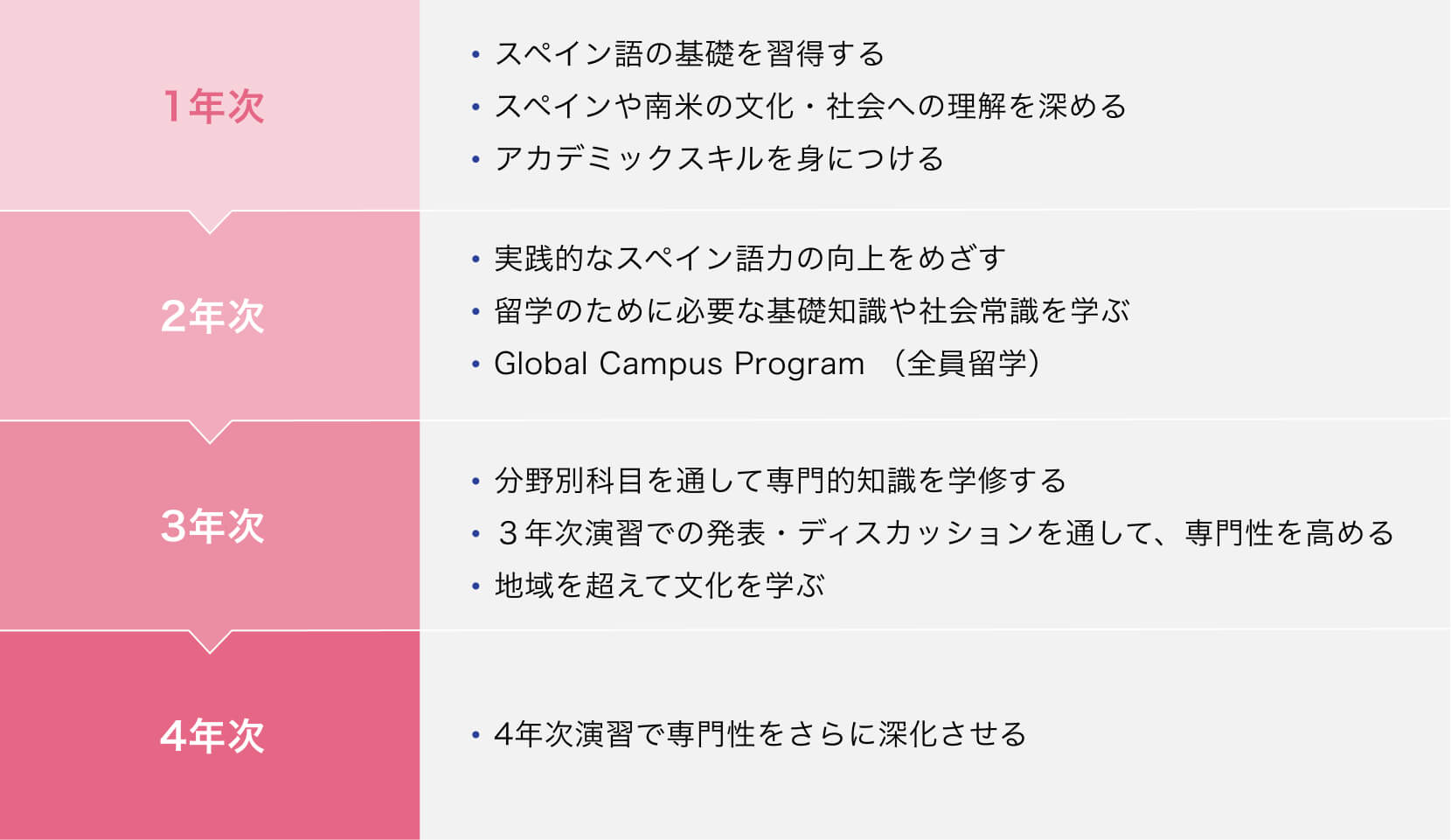
- 八王子キャンパス
外国語学部 外国語学科 スペイン語コース

- 八王子キャンパス

広大なスペイン語圏と日本の架け橋として
活躍できる人材を育成します
スペイン語は、世界で英語などとならび多くの国々で、多くの人びとに使われている言語です。スペイン語コースでは、語学修得とともにスペインおよびラテンアメリカ文化への理解を深めます。スペイン語によるプレゼンテーション能力を高めたり、日本に住むラテンアメリカの方々と交流するなど、座学にとどまらない実践的な学びにより、将来的に、スペイン語圏の国々と日本との架け橋として活躍できる人材の育成をめざしています。

スペイン語でプレゼンテーションする授業を実施
日常会話の中には、さまざまな現代的話題が出てきます。それらについても自分の見方を説明できることが重要です。この授業では、履修者はさまざまなテーマについてスペイン語の資料を用い、全員の前でプレゼンテーションを行います。聞き取り能力を鍛えスペイン語で質問もできるよう授業のほとんどをスペイン語で行います。
スペイン語コースでは、実用的なスペイン語力を高め、専門的な研究へと発展させる体系的なカリキュラムを設定しています。1年次は基本的な文法を学び、日常生活で必要な最低限のスペイン語を運用できるレベルをめざします。2年次ではその知識を専門的な学習へと発展させ、3年次のセミナーでは発表やディベートを通じて学生同士が主体的に学びます。4年次でさらに高度な専門研究にチャレンジし、集大成としての卒論などに取り組みます。

基礎スペイン語
本授業では、アルファベットから始まり複雑な文法もわかりやすく一つひとつ丁寧に説明しつつ、折に触れてスペイン語圏の文化も紹介します。スペイン語の文法的基礎を身につけるとともに、①スペイン語の簡単な文章を正確に音読して意味を理解できる、②自分と家族、日常生活などを他者に紹介できる、③簡単な手紙やメールを書けるようになることをめざします。
スペイン語翻訳
留学を終えて中級文法と日常会話レベルのスペイン語を習得した学生が、高度な翻訳技術を身につけることを目標としています。スペイン語の文章を、単語の意味をつなげて「なんとなく意味がわかる」のではなく、文法知識を踏まえて正確に理解し、正しい日本語の文章に訳す技術を学びます。ニュースや小説、漫画などを教材としてタイプの異なる翻訳に挑戦します。
スペイン語圏事情
スペイン語の背景にあるスペインとラテンアメリカの社会、歴史、文化を基礎から修得します。前半は北アメリカ大陸のメキシコ、中央アメリカ、南アメリカおよびカリブ海地域を含む広大なラテンアメリカが対象です。先住民文化、アフロアメリカ文化、イベロアメリカ文化の混淆を生み出した歴史を中心に学びます。後半は南ヨーロッパのスペインを対象とします。他のヨーロッパ諸国との違いや、スペインの地方文化の多様性がいかに形成されてきたのかを自然環境と歴史の観点から考えます。
演習
セミナー、ゼミとも呼ばれる授業です。自律的な学習ができる学生の育成をめざす科目です。スペイン語圏の社会、歴史、文化などから興味あるテーマを選び、自ら資料を探して調査し、その結果を発表(プレゼンテーション)します。ほかのゼミ生からコメントや感想を貰い、質疑応答をする中で多くの気づきがあります。期末にはこの過程を総合してレポートにまとめます。留学で発見したテーマ、さらに興味がわいたテーマをゼミで深めましょう。
GPA(Grade Point Average)制度の導入の趣旨は、1. キャンパスとして統一した基準を作成すること、2. 公平性に優れた基準であること、3. 国際的に通用する基準であることとし、学修の成果をGPAという客観的な数値で評価するものです。またこの制度は、欧米の大学で採用されている成績評価制度に概ね準拠しており、海外留学、海外の大学院進学、外資系企業への就職などの際に学力を証明する指標として、海外でも通用する成績評価制度となっています。
| 区分 | 評価 | GPA | 成績評価基準 | 評価内容 | 英文内容 |
|---|---|---|---|---|---|
| 合格 | S | 4.0 | 90点以上 | 特に優れた成績を表します | Excellent |
| A | 3.0 | 80点台 | 優れた成績を表します | Good | |
| B | 2.0 | 70点台 | 妥当と認められる成績を表します | Satisfactory | |
| C | 1.0 | 60点台 | 合格と認められる最低限の成績を表します | Pass | |
| 不合格 | D | 0.0 | 60点未満 | 合格と認められる最低限の成績に達していないことを表します。また、授業等の出席日数不足および当該授業における試験の未受験等も含みます | Failure |
| 対象外 | N | - | - | 編入や留学等により他大学等で修得した科目を本学の単位として認定したことを表します(単位認定科目) | Credits Transferred |

| 科目区分 | 必修・選択の例 | 所要単数 | ||||
|---|---|---|---|---|---|---|
| 共 通 教 育 科 目 ※4 | 教養 教育科目 | 人文科学系分野 | 選択必修 | 2以上 | 8以上 | 30※1 |
| 社会科学系分野 | 2以上 | |||||
| 自然科学系分野 | 2以上 | |||||
| 文理融合分野 | 選択 | - | ||||
| 初年次 教育科目 | ライフデザイン演習Ⅰ・Ⅱ | 必修 | 2 | |||
| キャリア教育科目 | 選択必修 | 2 | ||||
| 情報教育科目 | 選択必修 | 2 | ||||
| 外国語教育科目 | 選択 | - | ||||
| 専門科目※4 | 必修 | 39 | 74※3 | |||
| 選択必修※2 | 4 | |||||
| 選択 | 31 | |||||
| 自由選択 | ・専門科目74単位の超過単位 ・共通教育科目30単位の超過単位 ・オープン科目の修得単位 ・副専攻プログラムの修得単位 ・他大学での認定単位 | 選択 | 20 | |||
| 合計 | 124 | |||||